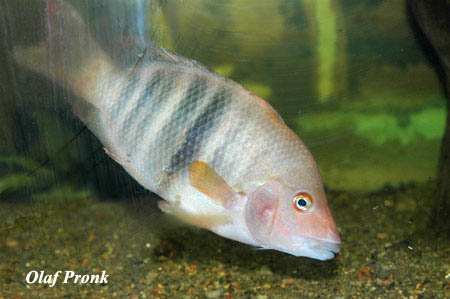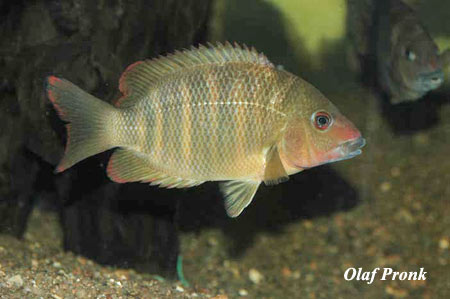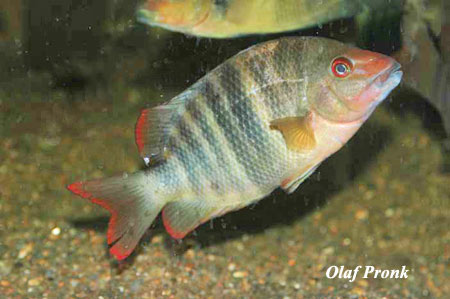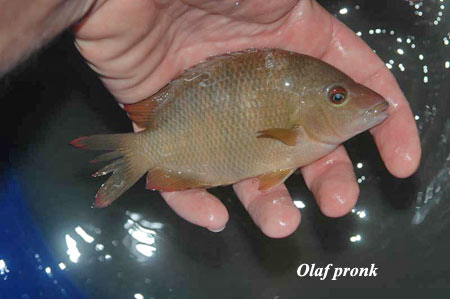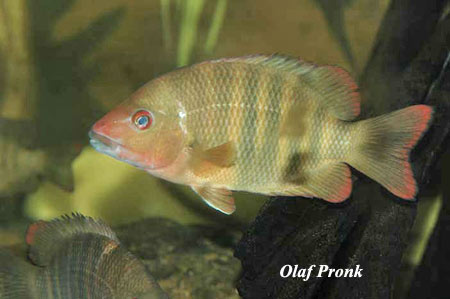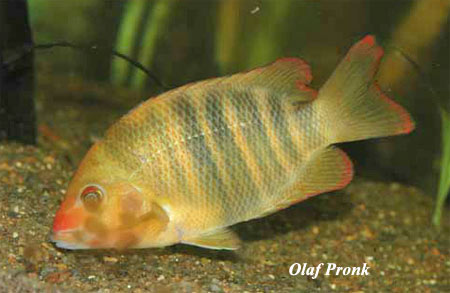| Paretroplus sp aff. nourissati |
Olaf Pronk : 17/11/06 :
Last week, my friend and collaborator
Jurgen “Nero” Spannring managed to catch, with help of a local fisherman,
three Paretroplus species in a single small lake about 30 kilometers
East of Port Bergé. The most remarkable of these I think is
Paretroplus menarambo ! The species is thus not completely
extinct. The other two species are Paretroplus kieneri and
Paretroplus nourissati like fish. The Paretroplus aff.
kieneri is said to turn completely red during the breeding season.
The Paretroplus aff.nourissati grows to nearly 30 cms total length.
It is also different from typical Paretroplus nourissati by a higher
body and red coloration on the forehead and all the fins and tail. The
fish can turn at least as intensively colored as typical Paretroplus
nourissati in breeding dress. The bad news is that the local fisherman
said that the Paretroplus species in the lake have become much rarer
over the years. Also, snakehead fish and Tilapia are already common
in the lake and the water, that used to be clear has now a drabby kind
of color. The local fisherman claims there is a fourth cichlid in the lake
but we have not been able to catch it yet.
La semaine dernière, mon ami et
collaborateur Jurgen « Nero » Spannring est parvenu à
attraper, avec l'aide d'un pêcheur local, trois espèces
de Paretroplus dans un petit lac à environ 30 kilomètres
à l'est de Port Bergé. Je pense que le plus remarquable
est Paretroplus menarambo.! L' espèces n'est ainsi pas complètement
éteinte. Les deux autres espèces sont P.kieneri et
un Paretroplus ressemblant à P. nourissati. P.
aff kieneri vire complètement au rouge pendant la saison de
reproduction. Le Paretroplus aff.nourissatii atteint presque 30
cm de longueur totale. Il est également différent du nourissatii
typique par un corps plus élevé et la coloration rouge sur
le front et toutes les nageoires et la queue. En robe nuptiale, les poissons
peuvent être aussi intensivement colorés que P. nourissati
typique. Les mauvaises nouvelles sont que le pêcheur local a
dit que les espèces de Paretroplus sont devenues beaucoup
plus rares au cours des années dans le lac. En outre, les Channa
et le Tilapia sont déjà communs dans le lac et l'eau, qui
était claire a maintenant une coloration opaque (?). Les pêcheurs
locaux affirment qu'il y a une quatrième espèce dans le lac
mais nous n'avons pas encore pu l'attraper.
